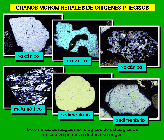Inherited minerals (more or less transformed
from the original material) predominate in soils. These minerals
have been useful in genetic studies of soils with regard to the
following guidelines:
Extending knowledge of the parent rock
Lithological discontinuities and buried palaeosols
Origin of minerals, development and nature of the alterations
Nature and degree of the alterations
Extending knowledge of the parent rock
![]() Sand mineralogy
reflects the mineralogy of the original material (rock or sediment)
that the soil comes from.
Sand mineralogy
reflects the mineralogy of the original material (rock or sediment)
that the soil comes from.

This relation materialises in a series of aspects, for example:
![]() Polymineralic grains
directly conserving the mineralogy and the microstructure of the
rock.
Polymineralic grains
directly conserving the mineralogy and the microstructure of the
rock.

![]() Monomineralic grains
indicating a specific petrological origin. For example, quartz
grains with features of precise origins (KRYNINE, 1946):
Monomineralic grains
indicating a specific petrological origin. For example, quartz
grains with features of precise origins (KRYNINE, 1946):

![]() Minerals that
would go unnoticed in the parent rock as they are found in very
scarce quantities and which concentrate in the soil in this fraction.
This is the case of the majority of the heavy minerals: haematite,
goethite, maghemite, tourmaline, garnet, andalusite, disthene
and staurolite.
Minerals that
would go unnoticed in the parent rock as they are found in very
scarce quantities and which concentrate in the soil in this fraction.
This is the case of the majority of the heavy minerals: haematite,
goethite, maghemite, tourmaline, garnet, andalusite, disthene
and staurolite.
Finally, we think it is interesting to note that the contribution
of coarse sands to the knowledge of the original material can
be extremely interesting in those cases in which there are certain
limits to directly accessing the original material, such as the
case of very deep soils (for example, very evolved soils, extremely
thick soils with calcic horizons, etc.) or, on the contrary, soils
formed on thin surface deposits with all their horizons intensely
weathered and therefore without the primitive features of the
original material being conserved.